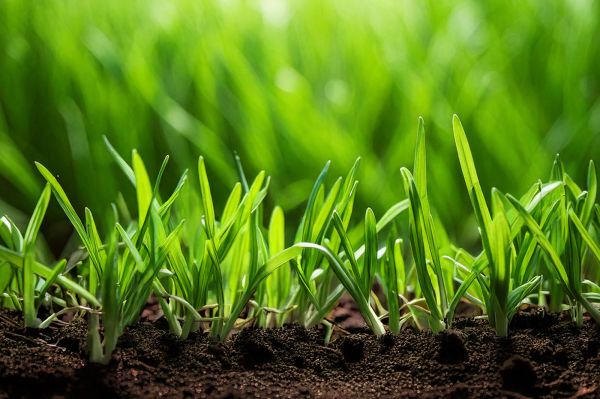
April: optimum reseeding time

This is the optimum time of year for reseeding. People do it whenever they can, but if you want to get a good establishment and good value out of the reseed for the coming months, now is the time.
April is usually when the weather is getting warmer. It's often drier and the days are getting longer. During the next few weeks, conditions usually allow for a successful strike to get strong plant establishment.
Clover inclusion
We've seen a big rise in the interest in clover in recent years, especially for derogation farms where clover inclusion is mandatory. Most farmers are now including clover in the mix. Where we used to have 600g in a 12kg bag, most are now looking for a kilogramme, maybe two kilogrammes of clover in an acre pack to try and reduce the nitrogen fertiliser requirement.
When it comes to diploid or tetraploid grass variety choices, without getting too technical, it's to do with the plant cells. Diploids have two sets of chromosomes in them and tetraploids have four. But in terms of practicalities that makes a big difference on farm because your tetraploids are bigger plants. They've got bigger cells. So, they've got more of the digestible bits that the cows want for nutrition. Typically, our tetraploid varieties are higher quality than diploid varieties. At DLF in the last few years, we've been pushing the tetraploid message a lot in terms of quality grazing and achieving good grazing management and graze-outs with tetraploids, or high tetraploid content mixtures. People might have an idea that they are more prone to poaching. But I think it comes down to management and that's in the farmer's control around getting ground grazed in good conditions and good weather. Heavy poaching should be avoided, no matter what the grass variety content of the sward. Some marking of the ground at this time of the year is probably inevitable. There isn't a diploid or tetraploid that's going to save you from doing that, so I wouldn't get too hung up on it.
The latest developments
In terms of our trials, we breed our own varieties at DLF. They come from our colleagues in Denmark and Holland. We evaluate them locally. A big part of that evaluation involves cutting and weighing all the varieties, as well as getting them out on farms and seeing how they perform under all conditions. That allows assessments on poaching resistance, as well as wet or dry weather and cool growing conditions. We've a new variety that we're bringing to the market this year. It's called Vast and it's one that showed up well in farm trials over the last five years. It's a late tetraploid with really good spring growth and producing good graze-outs. We're achieving that low residual that we want for good grassland management very easily and consistently with this variety. That's part of its tetraploid makeup. We're seeing this with Tetraploids in general that it's easier to get these varieties grazed out and to get better quality grass regrowth in the following rotations.
Why reseed?
If we think about it in terms of the efficient use of nitrogen, you would definitely produce greater bulk with a lot less nitrogen in a new sward because those varieties are fresher. They're making better use of soil nutrients. There's a lot of wastage of nutrients in the older swards because we're putting on high doses of nitrogen and the plants just aren't genetically able to optimise the use of those nutrients. Ultimately, new grass sward vigour somewhat reduces over time. How do we get around that? One way to reinvigorate the sward, apart from reseeding again, is to over-sow regularly. This can also be useful where some poaching has taken place. Broadcasting new seed onto the ground can thicken those swords up and bring some of the vigour back. It’s hard to kill grass. It’s a resilient plant. Where we get most comments about vigour is in high production, intensive systems where slippage, in terms of production, really affects the bottom line. If we're pushing the boundaries in terms of production efficiency, we need to be reseeding more often than the ten or fifteen or even twenty year cycles some farmers are using
The reseeding method
People will tell you that their machine is the best and that's fine. I think it's down to the user and having the ground prepared properly. Whatever method is used, we want a good, clean seedbed. We must get rid of as much of that old grass trash as possible, so it doesn’t interfere with the reseeds. Your seed bed prep is key. After that, the machine type doesn't really matter. If we take a few steps back, there are ways to do it without disturbing the soil too much. A lot of farmers are direct drilling seed into the old grass stubble. The key with that, for maximum success, is to get as much of the trash off as possible by prior grazing or cutting to give the new seeds the best start.
Weed control is a big topic these days, especially with the amount of clover that's being sown and farmers are keen to keep that clover in their swards. The easiest way to get clover into a sword is through a reseed. However, with the ever-limiting chemistry that we can use, that can sometimes be an issue. In a lot of cases, we might not need that much post emergence treatment if we're in a clean field. That's site specific and unique to individual reseeding projects.
In terms of the general management, we should be grazing our new grass at seven or eight weeks after sewing. We can do the pull test to make sure that new seedlings are established and have a good grip in the ground so they're not going to be pulled out by grazing animals. The first grazing should be at a cover of around one thousand kilograms per hectare. We graze a low cover and that'll help thicken up the sward. The plants start to tiller, sending out side-shoots which will give us more grass in the next round. In the first twelve months of a new pasture's life, the ideal is just to graze it and keep grazing it. If practical, leave the silage cuts until the following year to give it a good chance to establish and get all these tillers up and active.




